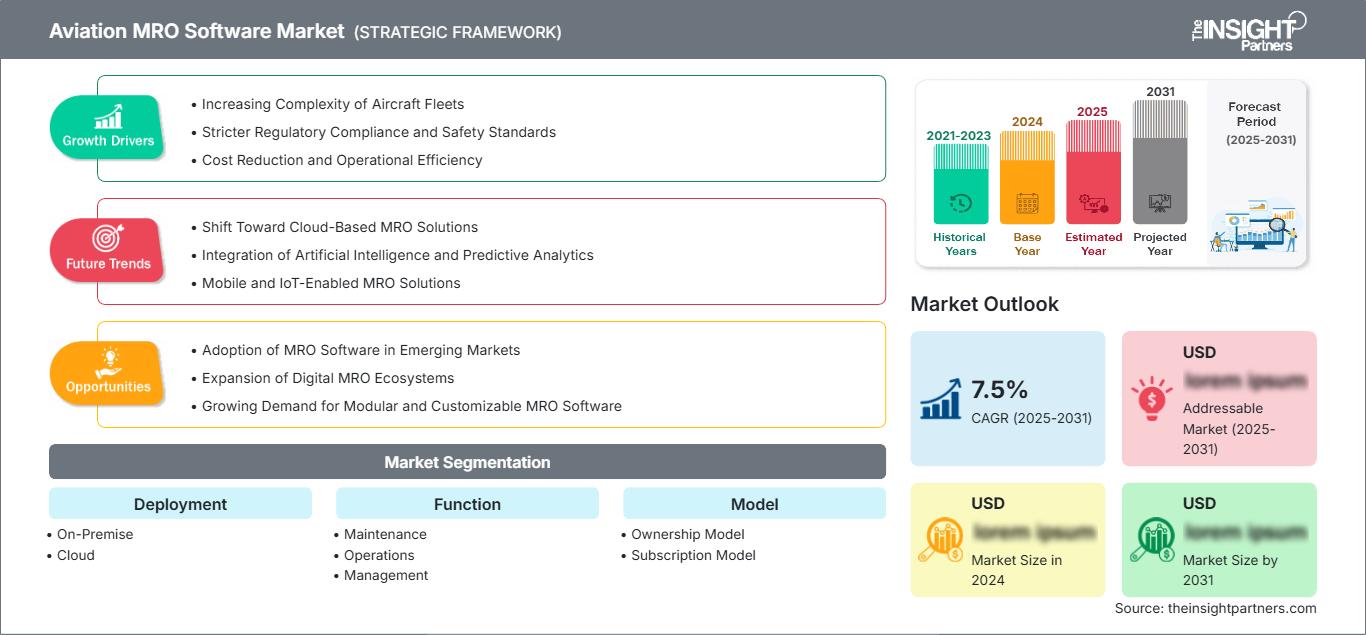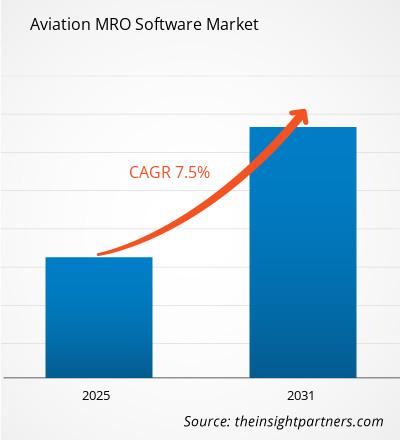Si prevede che il mercato del software MRO per l'aviazione raggiungerà i 14,31 miliardi di dollari entro il 2031. Si prevede che il mercato registrerà un CAGR del 6,3% nel periodo 2025-2031.
Il rapporto è segmentato per distribuzione (on-premise, cloud), funzione [manutenzione (linea, base, motore), operazioni, gestione], modello (modello di proprietà, modello di abbonamento). L'analisi globale è ulteriormente suddivisa a livello regionale e per i principali paesi. Il rapporto offre il valore in dollari per l'analisi e i segmenti sopra indicati.
Scopo del rapporto
Il rapporto Aviation MRO Software Market di The Insight Partners mira a descrivere il panorama attuale e la crescita futura, i principali fattori trainanti, le sfide e le opportunità. Ciò fornirà spunti a vari stakeholder aziendali, come:
- Fornitori/produttori di tecnologia: per comprendere le dinamiche di mercato in evoluzione e conoscere le potenziali opportunità di crescita, consentendo loro di prendere decisioni strategiche informate.
- Investitori: per condurre un'analisi completa delle tendenze in merito al tasso di crescita del mercato, alle proiezioni finanziarie del mercato e alle opportunità esistenti lungo la catena del valore.
- Organismi di regolamentazione: per regolamentare le politiche e le attività di controllo nel mercato con l'obiettivo di ridurre al minimo gli abusi, preservare la fiducia degli investitori e sostenere l'integrità e la stabilità del mercato.
Segmentazione del mercato del software MRO per l'aviazione e distribuzione
- On-Premise
- Cloud
Funzione
- Manutenzione
- Operazioni
- Gestione
Modello
- Modello di proprietà
- Modello di abbonamento
Geografia
- Nord America
- Europa
- Asia-Pacifico
- America meridionale e centrale
- Medio Oriente e Africa
Potrai personalizzare gratuitamente qualsiasi rapporto, comprese parti di questo rapporto, o analisi a livello di paese, pacchetto dati Excel, oltre a usufruire di grandi offerte e sconti per start-up e università
Mercato del software MRO per l'aviazione: Approfondimenti strategici

-
Ottieni le principali tendenze chiave del mercato di questo rapporto.Questo campione GRATUITO includerà l'analisi dei dati, che vanno dalle tendenze di mercato alle stime e alle previsioni.
Fattori di crescita del mercato del software MRO per l'aviazione
- Crescente complessità delle flotte di aeromobili: con l'aggiornamento delle flotte da parte di compagnie aeree e operatori per includere aeromobili più avanzati e tecnologicamente sofisticati, è cresciuta la necessità di soluzioni software integrate per la manutenzione, la riparazione e la revisione (MRO). Gli aeromobili moderni sono dotati di sistemi più complessi, che richiedono un monitoraggio e una gestione avanzati delle attività di manutenzione. Il software MRO consente una gestione efficiente dei programmi di manutenzione, degli inventari dei ricambi e dei registri di conformità, garantendo che questi aeromobili rimangano operativi e rispettino le normative di sicurezza. La crescente complessità delle flotte a livello globale, soprattutto nelle regioni con elevato traffico aereo, sta alimentando la domanda di soluzioni software MRO.
- Conformità normativa e standard di sicurezza più rigorosi: il settore dell'aviazione è altamente regolamentato, con autorità come FAA, EASA e ICAO che applicano linee guida rigorose per la sicurezza e la manutenzione degli aeromobili. Queste normative impongono alle compagnie aeree di mantenere registri completi, eseguire ispezioni regolari e rispettare i protocolli di sicurezza. Il software MRO aiuta le aziende ad automatizzare il monitoraggio della conformità, gestire la documentazione in modo efficiente e generare i report necessari per garantire il rispetto delle normative locali e internazionali. Il continuo inasprimento delle normative di sicurezza rappresenta un importante motore per l'adozione del software MRO nelle operazioni di trasporto aereo.
- Riduzione dei costi ed efficienza operativa: in un contesto competitivo come quello del trasporto aereo, gli operatori sono costantemente sotto pressione per ridurre i costi di manutenzione e migliorare al contempo l'efficienza operativa. Il software MRO consente alle aziende di ottimizzare i programmi di manutenzione, ridurre i tempi di fermo non programmati e prolungare la durata di vita dei componenti critici. Automatizzando vari processi, come la gestione degli ordini di lavoro, il monitoraggio dell'inventario e la pianificazione della manodopera, le aziende aeronautiche possono ridurre i costi, ridurre gli errori umani e semplificare le operazioni, rendendo il software MRO uno strumento prezioso per ottenere risparmi sui costi e miglioramenti dell'efficienza.
Tendenze future del mercato del software MRO per l'aviazione
- Spostamento verso soluzioni MRO basate su cloud: le soluzioni software MRO basate su cloud stanno diventando sempre più popolari nel settore dell'aviazione. La tecnologia cloud consente l'accesso ai dati in tempo reale, l'archiviazione centralizzata e una collaborazione fluida tra team geograficamente distribuiti. Le compagnie aeree e i fornitori di servizi di manutenzione, riparazione e ristrutturazione (MRO) stanno adottando piattaforme cloud per migliorare la condivisione dei dati tra i reparti, ottimizzare il processo decisionale e ridurre i costi IT. La scalabilità e la flessibilità offerte dalle soluzioni cloud stanno guidando il passaggio dai tradizionali software on-premise ai sistemi MRO basati su cloud, consentendo alle compagnie aeree di gestire le proprie operazioni in modo più efficace ed economico.
- Integrazione di intelligenza artificiale e analisi predittiva: l'integrazione di intelligenza artificiale e analisi predittiva nei software MRO sta trasformando il modo in cui la manutenzione viene gestita nel settore dell'aviazione. Analizzando i dati storici e utilizzando algoritmi di apprendimento automatico, i software MRO basati sull'intelligenza artificiale possono prevedere potenziali guasti alle apparecchiature e ottimizzare i programmi di manutenzione. La manutenzione predittiva aiuta a identificare i problemi prima che si verifichino, riducendo i tempi di fermo non programmati e le costose riparazioni. Questa tendenza verso soluzioni software MRO potenziate dall'intelligenza artificiale sta semplificando la gestione delle flotte da parte delle compagnie aeree, consentendo loro di prevenire costose interruzioni operative.
- Soluzioni MRO basate su dispositivi mobili e IoT: il crescente utilizzo di dispositivi mobili e dell'Internet of Things (IoT) nelle operazioni di trasporto aereo sta influenzando lo sviluppo di software MRO. Le soluzioni MRO basate su dispositivi mobili consentono ai team di manutenzione di accedere a dati, registri e ordini di lavoro in tempo reale direttamente dal campo, migliorando i tempi di risposta e l'efficienza della manutenzione. L'integrazione IoT consente ai dispositivi sugli aeromobili di comunicare direttamente con il software MRO, fornendo dati continui sulle prestazioni dei componenti. Questa tendenza sta migliorando la capacità di eseguire la manutenzione predittiva, migliorare il monitoraggio delle risorse e fornire informazioni in tempo reale sulle operazioni di manutenzione, favorendo l'adozione di queste soluzioni MRO avanzate.
Opportunità di mercato per il software MRO per l'aviazione
- Adozione di software MRO nei mercati emergenti: i mercati emergenti, in particolare nell'area Asia-Pacifico, nel Medio Oriente e in Africa, offrono significative opportunità di crescita per il mercato del software MRO per l'aviazione. Queste regioni stanno registrando una rapida crescita del trasporto aereo, con conseguente aumento della domanda di servizi di manutenzione e strumenti software sofisticati. Con la modernizzazione delle flotte e l'aumento della scala operativa da parte delle compagnie aeree e degli operatori di queste regioni, aumenterà la necessità di soluzioni software MRO efficienti. Questa tendenza offre ai fornitori di software MRO l'opportunità di espandere la propria presenza e offrire soluzioni personalizzate per soddisfare le esigenze specifiche di questi mercati in crescita.
- Espansione degli ecosistemi MRO digitali: lo sviluppo di ecosistemi MRO digitali, in cui le piattaforme software si integrano con vari stakeholder come compagnie aeree, fornitori di servizi di manutenzione, OEM (Original Equipment Manufacturer) e fornitori, offre ai fornitori di software l'opportunità di creare soluzioni complete ed end-to-end. Questi ecosistemi consentono uno scambio di dati continuo, una migliore collaborazione e il monitoraggio in tempo reale di componenti e servizi lungo l'intera catena di fornitura. Integrando le proprie piattaforme con altri stakeholder del settore, i fornitori di software possono migliorare la proposta di valore delle proprie soluzioni MRO e rispondere alla crescente domanda di operazioni di manutenzione interconnesse e semplificate.
- Crescente domanda di software MRO modulare e personalizzabile: poiché le compagnie aeree e i fornitori di servizi di manutenzione cercano di ottimizzare le proprie operazioni, cresce la domanda di soluzioni software MRO modulari e personalizzabili, personalizzabili per soddisfare esigenze specifiche. Le compagnie aeree con flotte diversificate richiedono software in grado di gestire diverse tipologie di aeromobili, programmi di manutenzione e requisiti di conformità. I fornitori che offrono soluzioni flessibili e modulari, in cui è possibile aggiungere o personalizzare singoli moduli per la gestione dell'inventario, la pianificazione della manutenzione e il monitoraggio della conformità, saranno molto richiesti. Questa flessibilità consente alle aziende di adottare software MRO che si adattino alle loro specifiche esigenze operative, aprendo opportunità agli sviluppatori software per innovare e diversificare la propria offerta.
Mercato del software MRO per l'aviazione
Le tendenze regionali e i fattori che influenzano il mercato del software MRO per l'aviazione durante il periodo di previsione sono stati ampiamente spiegati dagli analisti di The Insight Partners. Questa sezione illustra anche i segmenti di mercato e la geografia della gestione delle malattie del ritmo cardiaco in Nord America, Europa, Asia-Pacifico, Medio Oriente e Africa, America meridionale e centrale.
Ambito del rapporto di mercato del software MRO per l'aviazione
| Attributo del rapporto | Dettagli |
|---|---|
| Dimensioni del mercato in 2024 | US$ XX Billion |
| Dimensioni del mercato per 2031 | US$ 14.31 Billion |
| CAGR globale (2025 - 2031) | 6.3% |
| Dati storici | 2021-2023 |
| Periodo di previsione | 2025-2031 |
| Segmenti coperti |
By Distribuzione
|
| Regioni e paesi coperti |
Nord America
|
| Leader di mercato e profili aziendali chiave |
|
Densità degli operatori del mercato del software MRO per l'aviazione: comprendere il suo impatto sulle dinamiche aziendali
Il mercato dei software MRO per l'aviazione è in rapida crescita, trainato dalla crescente domanda degli utenti finali dovuta a fattori quali l'evoluzione delle preferenze dei consumatori, i progressi tecnologici e una maggiore consapevolezza dei vantaggi del prodotto. Con l'aumento della domanda, le aziende stanno ampliando la propria offerta, innovando per soddisfare le esigenze dei consumatori e sfruttando le tendenze emergenti, alimentando ulteriormente la crescita del mercato.

- Ottieni il Mercato del software MRO per l'aviazione Panoramica dei principali attori chiave
Punti di forza
- Copertura completa: il rapporto analizza in modo esaustivo prodotti, servizi, tipologie e utenti finali del mercato del software MRO per l'aviazione, fornendo una panoramica olistica.
- Analisi degli esperti: il rapporto è redatto sulla base della conoscenza approfondita di esperti e analisti del settore.
- Informazioni aggiornate: il rapporto garantisce la pertinenza aziendale grazie alla copertura di informazioni e tendenze dei dati recenti.
- Opzioni di personalizzazione: questo rapporto può essere personalizzato per soddisfare le esigenze specifiche del cliente e adattarsi in modo appropriato alle strategie aziendali.
Il rapporto di ricerca sul mercato del software MRO per l'aviazione può quindi contribuire a guidare il percorso di decodificazione e comprensione dello scenario del settore e delle prospettive di crescita. Sebbene possano esserci alcune valide preoccupazioni, i vantaggi complessivi di questo rapporto tendono a superare gli svantaggi.
- Analisi storica (2 anni), anno base, previsione (7 anni) con CAGR
- Analisi PEST e SWOT
- Valore/volume delle dimensioni del mercato - Globale, Regionale, Nazionale
- Industria e panorama competitivo
- Set di dati Excel
Report recenti
Rapporti correlati
Testimonianze
Motivo dell'acquisto
- Processo decisionale informato
- Comprensione delle dinamiche di mercato
- Analisi competitiva
- Analisi dei clienti
- Previsioni di mercato
- Mitigazione del rischio
- Pianificazione strategica
- Giustificazione degli investimenti
- Identificazione dei mercati emergenti
- Miglioramento delle strategie di marketing
- Aumento dell'efficienza operativa
- Allineamento alle tendenze normative






















 Ottieni un campione gratuito per - Mercato del software MRO per l'aviazione
Ottieni un campione gratuito per - Mercato del software MRO per l'aviazione